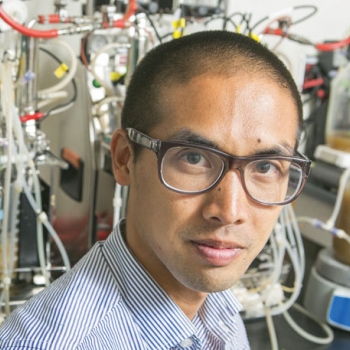
Year of Graduation:
Advisors/Lab:
Current Position:
Photo credit: Leslie Todd, Duke University
The David Lab is particularly interested in how commensal microbes help resist, and ultimately respond to, colonization by human pathogens. An active area of research is the longitudinal study of cholera infections among residents of Dhaka, Bangladesh. Primary research questions include: Can enteric microbial communities predict an individual's susceptibility to cholera? Why do bacterial ecological successions follow cholera infection? What long-term effects do infection and treatment have on commensal gut microbes? The David Lab is also broadly interested in developing new modeling and visualization tools for time-series of complex microbial communities, as well as exploring the ecology of human microbiota in the developing world.
Lawrence David is an Assistant Professor in GCB and the Department of Molecular Genetics & Microbiology. Lawrence began his research career as an undergraduate at Columbia University, where he studied biological network inference with Chris Wiggins. During his Ph.D. in Computational & Systems Biology at MIT, Lawrence worked with Eric Alm to reconstruct ancient microbial genomes and incorporate ecological adaptation into models of microbial genome evolution. Lawrence performed postdoctoral work as a Junior Fellow and Principal Investigator at Harvard's Society of Fellows, where he collaborated with Peter Turnbaugh on analyses of the human microbiome's response to diet- and disease-based perturbations.
Doctoral Thesis Title: Novel phylogenetic approaches to problems in microbial genomics
Publications while at MIT:
1. Host lifestyle affects human microbiota on daily timescales.
David LA, Materna AC, Friedman J, Campos-Baptista MI, Blackburn MC, Perrotta A, Erdman SE, Alm EJ.
Genome Biol. 2014;15(7):R89. Erratum in: Genome Biol. 2016;17(1):117. PMID: 25146375 Free PMC Article
2. Reproducibility of Vibrionaceae population structure in coastal bacterioplankton.
Szabo G, Preheim SP, Kauffman KM, David LA, Shapiro J, Alm EJ, Polz MF.
ISME J. 2013 Mar;7(3):509-19. doi: 10.1038/ismej.2012.134. Epub 2012 Nov 22. PMID: 23178668 Free PMC Article
3. Ecology drives a global network of gene exchange connecting the human microbiome.
Smillie CS, Smith MB, Friedman J, Cordero OX, David LA, Alm EJ.
Nature. 2011 Oct 30;480(7376):241-4. doi: 10.1038/nature10571. PMID: 22037308
4. Rapid evolutionary innovation during an Archaean genetic expansion.
David LA, Alm EJ.
Nature. 2011 Jan 6;469(7328):93-6. doi: 10.1038/nature09649. Epub 2010 Dec 19. PMID: 21170026
5. Metapopulation structure of Vibrionaceae among coastal marine invertebrates.
Preheim SP, Boucher Y, Wildschutte H, David LA, Veneziano D, Alm EJ, Polz MF.
Environ Microbiol. 2011 Jan;13(1):265-275. doi: 10.1111/j.1462-2920.2010.02328.x. Epub 2010 Sep 1.PMID: 20819104
6. Looking for Darwin's footprints in the microbial world.
Shapiro BJ, David LA, Friedman J, Alm EJ.
Trends Microbiol. 2009 May;17(5):196-204. doi: 10.1016/j.tim.2009.02.002. Epub 2009 Apr 15. Review.PMID: 19375326
7. Resource partitioning and sympatric differentiation among closely related bacterioplankton.
Hunt DE, David LA, Gevers D, Preheim SP, Alm EJ, Polz MF.
Science. 2008 May 23;320(5879):1081-5. doi: 10.1126/science.1157890.PMID:18497299 Free Article
